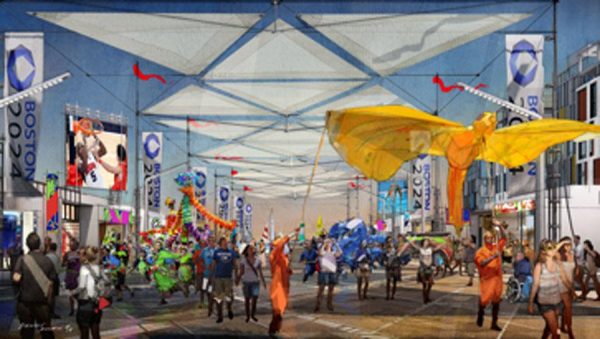Beware a Generic Olympics!

Now that Boston has prevailed as a finalist for the 2024 Olympics, it’s time for the Boston 2024 Organizing Committee to make several important additions to their list of planning priorities. In addition to launching a public outreach campaign to seek public input and garner more support for the Games, the Committee should understand and promote their cultural potential. I hope design innovation is a focus for the next round of planning. One of my platforms when I ran as BSA President was to promote initiatives that would help Boston become a global design city like Copenhagen and Montreal. Planning for the Olympics is the perfect vehicle to help meet this goal.
The proposal to date already includes progressive planning strategies, including a focus on mass transit, building reuse, and walkability. In fact, these attributes were a key factor in the win because they helped make a case for a relatively low overall price tag. But this forward-looking approach needs to migrate into finer-grain decisions, including the architectural characteristics of buildings large and small, the branding of the Games, and the visual quality of the spectacles that are a hallmark of the Olympics. A refined proposal should fully leverage the incredible talent in Boston across disciplines that include architecture, landscape interactive lighting design, industrial design, and graphic design. In addition, the MIT SENSEable City and Media Labs and the professors and research fellows at area design schools should be a resource.
The Olympics provide the perfect opportunity to foster a wider bandwidth of design practices because design thinking will be needed to inform both large-scale planning decisions and to help define the physical character of multiple facilities and events. First and foremost, the new sports venues and the Olympic Village need to pull in and showcase the larger city. The generic rendering of the Boston Games that were published in yesterday’s Globe (see above) looked like they could have been located anywhere and were probably produced by the hand of someone who has never been to Boston. The views of an Olympic Village along the Reserved Channel – produced by Yale students last spring – did a much better job of capturing the potential character of the Boston Games.
Proposed new facilities – like the modular stadium at Widett Circle and aquatics center – should show off Boston in the same dramatic way that Barcelona was displayed to the world in 1992 as the backdrop to the diving competitions.
Without a management plan that includes a strategy for effectively and efficiently outlining the design opportunities – and then marshaling the most creative people to help envision potential solutions – the Boston Olympics may turn out to be as generic, from a design perspective, as the 1996 Atlanta Games. Barcelona leveraged the Olympics to become an international center of architecture and design by marshaling that city’s established and emerging design talent. Boston has the same opportunity.
-Tim

